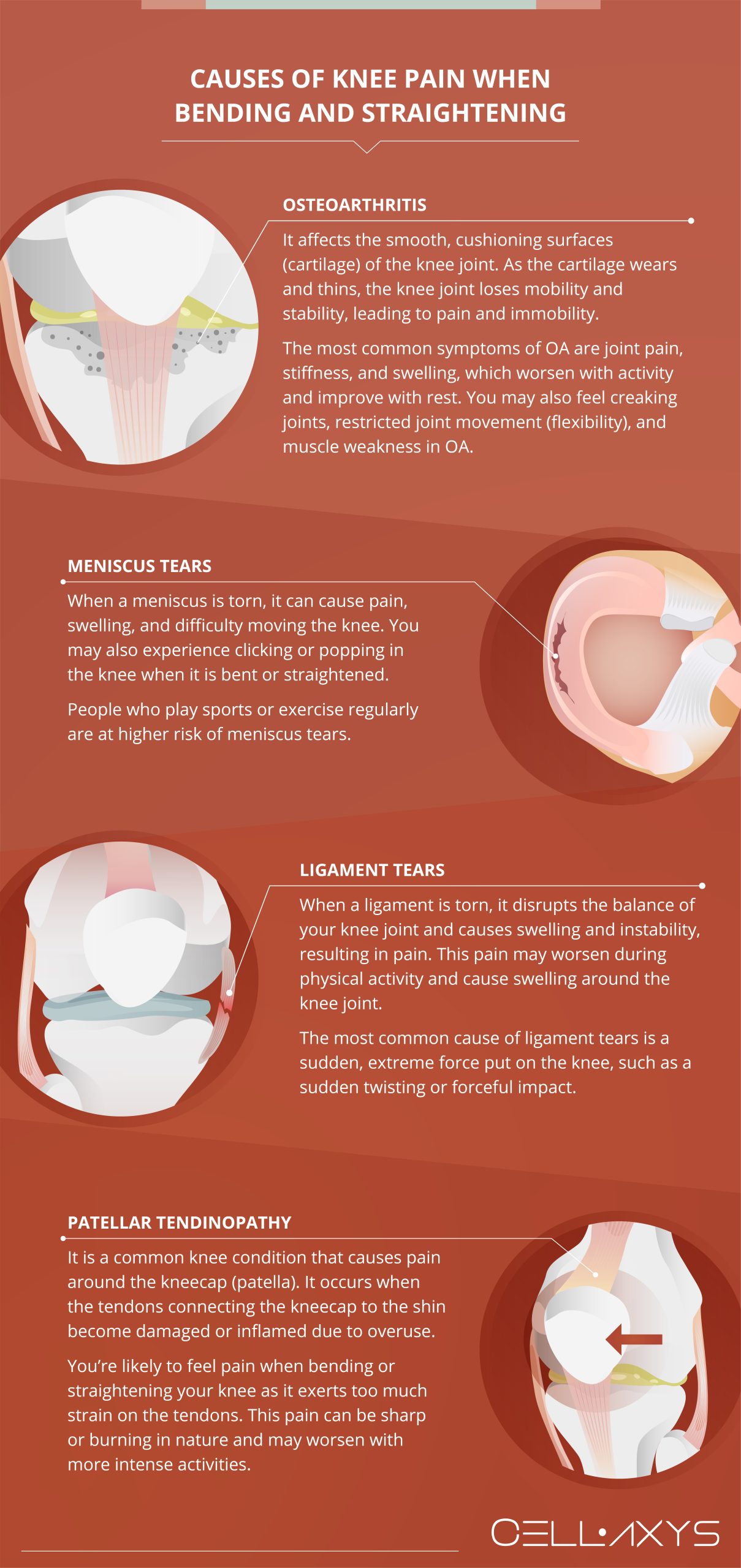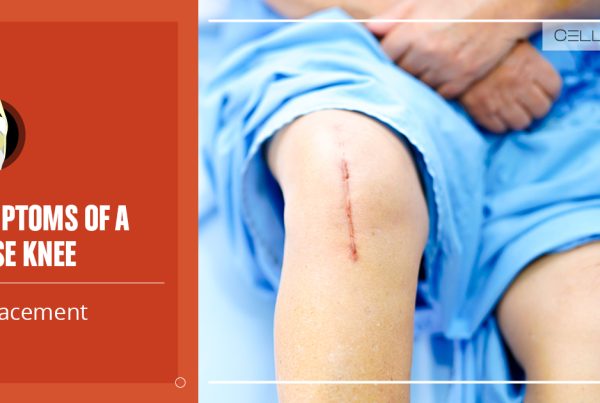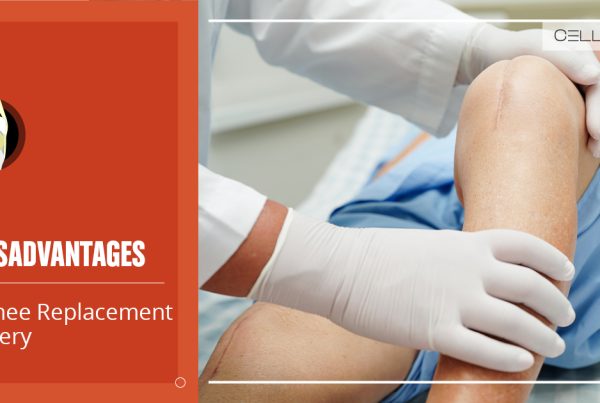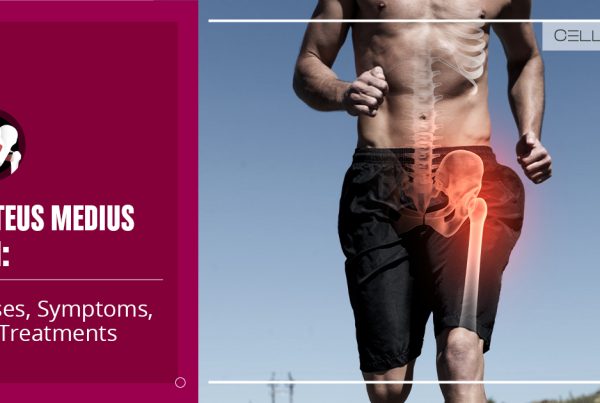Published on: January 29, 2023 | Updated on: January 18, 2025
Are you tired of dealing with persistent knee pain that worsens when you bend or straighten your knee? You’re not alone. Knee pain is one of the most common types of pain, and can sometimes be difficult to diagnose and treat.
As we age, our ligaments and tendons become weak and lead to severe pain when bending or straightening the knee. Your knee may also hurt due to trauma, twisting of the foot, increased body weight, or serious health issues, such as osteoarthritis, meniscus tears, ligament tears, or jumper’s knee.
Surgery is the last resort for knee pain. First, the doctor opts for conventional treatments like stretching and strengthening exercises, anti-inflammatory medicines, acupuncture, braces, massage, etc. Then, they may suggest non-invasive orthobiologic options or surgery.
Causes of Knee Pain When Bending and Straightening

The knee is incredibly important for movement and stability, as it bears a large portion of the body’s weight when we stand, walk, or run. Any injury or issue in this body part can cause severe pain that may radiate to the entire leg.
Knee pain when bending and straightening can be caused by various issues. The most common causes include the following:
Osteoarthritis
Osteoarthritis (OA) is a common condition that causes knee pain. OA is a degenerative joint disease that affects the smooth, cushioning surfaces (cartilage) of the knee joint. As the cartilage wears and thins, the knee joint loses mobility and stability, leading to pain and immobility.
The most common symptoms of OA are joint pain, stiffness, and swelling, which worsen with activity and improve with rest. You may also feel creaking joints, restricted joint movement (flexibility), and muscle weakness in OA.
Common risk factors of this condition include aging, advanced BMI (body mass index), and overloading the knee joint with physical stress. OA in the knees can also be triggered if you have any long-term disease, like diabetes, and genetic predispositions towards OA.
Meniscus Tears
A meniscus is a C-shaped piece of cartilage that acts as a cushion in the knee joint. It provides stability, helps maintain joint alignment, and absorbs shock when you put weight on your leg.
When a meniscus is torn, it can cause pain, swelling, and difficulty moving the knee. You may also experience clicking or popping in the knee when it is bent or straightened. In worse cases, you may also have additional knee problems, such as instability, limitation of motion, and clicking or locking when walking or running.
People who play sports or exercise regularly are at higher risk of meniscus tears. The most common cause of meniscus tears is injury or a sudden twist or rotation of the knee. Age is also a factor. As we age, the meniscus becomes thinner and more prone to tears.
Ligament Tears
Ligaments are tough, fibrous tissues that connect the bone to bone, providing support and stability to the knee joint. The four main ligaments in the knee include the medial collateral, lateral collateral, anterior cruciate, and posterior cruciate ligaments.
When a ligament is torn, it disrupts the balance of your knee joint and causes swelling and instability, resulting in pain. This pain may worsen during physical activity and cause swelling around the knee joint.
The most common cause of ligament tears is a sudden, extreme force put on the knee, such as a sudden twisting or forceful impact. A direct blow to the knee, either from an outside force or a fall, can also cause a ligament tear.
Patellar Tendinopathy
Patellar Tendinopathy, also known as Jumper’s Knee, is a common knee condition that causes pain around the kneecap (patella). It occurs when the tendons connecting the kneecap to the shin become damaged or inflamed due to overuse.
You’re likely to feel pain when bending or straightening your knee as it exerts too much strain on the tendons. This pain can be sharp or burning in nature and may worsen with more intense activities. You may also feel pain in activities like walking or climbing stairs, although this pain is often milder.
Treatment for Pain When Bending or Straightening the Knee
Treatment for pain when bending or straightening the knee depends on the underlying cause. The doctor typically recommends conventional treatments for knee pain, but if it sustains, they opt for other options like surgery or orthobiologic treatments.
Conventional Treatments
Conventional or non-surgical treatments for knee pain can vary from person to person. You can reduce your pain, restore mobility, and enjoy better overall joint health with the right treatment. Here are some non-surgical treatments for knee pain when bending or straightening it:
- Anti-inflammatory medications
- Physical therapy
- Specific braces
- Acupuncture
- Massage
- Heat and ice therapy
- Lifestyle changes, such as stress management, body weight control, eating a healthy, balanced diet, and taking part in regular exercise.
- Stretching and strengthening exercises
Orthobiologic Treatments
If your knee pain persists even after the conventional treatments, your doctor may ask you to try orthobiologic treatments. These non-invasive methods are based on regenerative medicine, which includes using your own body cells to promote healing in the injured area.
At CELLAXYS, we perform two types of regenerative therapy:
Platelet-rich plasma (PRP) therapy
Platelet-rich plasma (PRP) utilizes the healing components (platelets) from the patient’s own blood plasma. The doctor isolates platelets, processes them, and reinjects them into the injury site.
Platelets serve as the first line of defense against injuries or wounds. They release 10 Growth Factors to repair damaged tissues and produce fibrin that serves as the scaffolding for new tissue development.
A high number of platelets in your knee can help treat the causes of pain faster. PRP is a popular orthopedic, spine, and sports injury treatment performed in as little as 45 minutes.
Cell-based therapies
You may have heard about this treatment as “stem cell therapy,” which extracts healthy cells from a patient’s body and reinjects them in the injury site. When opting for cell-based therapies, your doctor will opt for any of the two types of cell-based therapies:
- Minimally Manipulated Adipose Tissue (MMAT) Transplant. In this process, the doctor extracts healthy cells from the patient’s adipose (fat) cells. The best part about MMAT is that it can be performed in multiple locations in the same procedure.
- Bone Marrow Concentrate (BMAC). In this process, the doctor takes highly concentrated cells from the bone marrow and injects them into your knee to heal the pain caused when bending or straightening it.
The doctor performs Both of these procedures while the patient is under anesthesia. The process is completed within 1.5 to 2 hours. To locate the exact spot, doctors use live X-rays or ultrasounds.
Both cell-based therapies and PRP therapies are outpatient procedures and, when used together, work to tackle the pain and the source of the knee pain. Patients report more effective and longer-lasting results from orthobiologic treatments than alternative treatments.
Sources
Footnotes
- Abramoff B, Caldera FE. Osteoarthritis: Pathology, Diagnosis, and Treatment Options. The Medical Clinics of North America. 2020;104(2):293-311.
- Bhan K. Meniscal Tears: Current Understanding, Diagnosis, and Management. Cureus. 2020 Jun 13;12(6):e8590.
- Cantor RM, Stern PJ, Wyrick JD, Michaels SE. The relevance of ligament tears or perforations in the diagnosis of wrist pain: an arthrographic study. The Journal of Hand Surgery. 1994;19(6):945-53.
- Schwartz A, Watson JN, Hutchinson MR. Patellar Tendinopathy. Sports Health. 2015;7(5):415-20.
- Jordan KM, Sawyer S, Coakley P, Smith HE, Cooper C, Arden NK. The use of conventional and complementary treatments for knee osteoarthritis in the community. Rheumatology (Oxford). 2004;43(3):381-4.
- Sanchis-Alfonso V, McConnell J, Monllau JC, Fulkerson JP. Diagnosis and treatment of anterior knee pain. Journal of ISAKOS. 2016;1(3):161-73.
References
- What Causes Knee Pain When You’re Bending It, and How’s It Treated?. Healthline. Accessed 9/7/2023.
- Why Do My Knees Hurt When Bending?. The Orthopaedic Institute. Accessed 9/7/2023.
- Top Causes of Knee Pain When Sitting or Bending. Verywell Health. Accessed 9/7/2023.
CELLAXYS does not offer Stem Cell Therapy as a cure for any medical condition. No statements or treatments presented by Cellaxys have been evaluated or approved by the Food and Drug Administration (FDA). This site contains no medical advice. All statements and opinions are provided for educational and informational purposes only.
Dr Pejman Bady
Author
Dr. Pejman Bady began his career over 20 years ago in Family/Emergency Medicine, working in fast-paced emergency departments in Nevada and Kansas. He has served the people of Las Vegas as a physician for over two decades. Throughout this time, he has been met with much acclaim and is now the head of Emergency Medical Services in Nye County, Nevada. More about the doctor on this page.
Dr Pouya Mohajer
Contributor
Pouya Mohajer, M.D. is the Director of Spine and Interventional Medicine for CELLAXYS: Age, Regenerative, and Interventional Medicine Centers. He has over 20 years of experience in pain management, perioperative medicine, and anesthesiology. Dr. Mohajer founded and is the Medical Director of Southern Nevada Pain Specialists and PRIMMED Clinics. He has dedicated his career to surgical innovation and scientific advancement. More about the doctor on this page.









